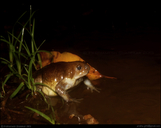|
Uperodon globulosus (Günther, 1864)
| family: Microhylidae subfamily: Microhylinae genus: Uperodon |
 © 2013 Prathamesh Ghadekar (1 of 4) |
|
|
|
Description Description: Adult males measure about 65 mm and females, 84 mm. In general, the dorsum is smooth skinned; the skin on the venter is wrinkled. The species has a small head, a rounded snout, and “beady” eyes. The tympanum is indistinct. U. globulosus has an interorbital width between its eyes that is 2.5-3 times larger than the width of the upper eyelid (Daniel 2002). An occipital fold is present and there is an indistinct fold from the eye to the shoulder. This fossorial species has short hindlimbs and metatarsal tubercles that are used as shovels for digging. The tibio-tarsal articulation does not reach the shoulder. The toes have a small amount of webbing. The fingers are distinct. The first finger is shorter than the second, which is longer than the fourth (Parker 1934; Daniel 2002). Coloration: In adults, Uperodon globulosus is usually solid brown/grey dorsally and white ventrally, but during breeding season, the throat is spotted with yellow and black (Daniel 2002). Tadpoles have an olive-brown coloration on the dorsum, with a whitish colored tail and dark blotchy longitudinal stripes. Its flanks and venter are both spotted with dark coloration (Daniel 2002). Distribution and Habitat Country distribution from AmphibiaWeb's database: Bangladesh, Bhutan, India, Nepal
U. globulosus is found in forest, inland wetland, and both artificial terrestrial and aquatic areas below 600 m in elevation (Dutta et al. 2004). Breeding occurs in very restricted localities in shallow ponds and marshes and has been found in Pune, in the Marashtra State (Padhye and Ghate 2002). Tadpoles were collected from Pashan-pune, but adults were absent at time of collection (Dutta et al. 2004; Padhye and Ghate 2002). Life History, Abundance, Activity, and Special Behaviors The breeding season is marked by the beginning of the monsoon season in western India. Calls resemble a grunting “oink” that assists females in mate search. According to current research, when ready to breed, U. globulosus will breed in any body of standing water, including ephemeral pools that don’t last more than a few days (Daniel 2002). Females then lay small eggs in copious amounts (Parker 1934). The tadpole stage is an active swimmer. It is microphagous, and therefore depends on particles in the water as their main food source (Daniel 2002). Trends and Threats Possible reasons for amphibian decline General habitat alteration and loss Comments The karyotype is as follows: 2n=26 (Chakrabarti 1978).
References
Chakrabarti, S. (1978). ''Somatic chromosomes of Indian burrowing toad, Uperodon globulosum (Günther) (Anura; Amphibia).'' Cellular and Molecular Life Sciences, 6(35), 743-44. Choudhury, P., Baruah, M. and Sengupta, S. (1999). ''Range extension in Uperodon globulosus (Gunter, 1864) in Assam.'' Journal of the Bombay Natural History, (96), 157. Daniel, J. C. (2002). The Book of Indian Reptiles and Amphibians. Oxford University Press, Oxford. Frost, D. (2011). Amphibian Species of the World: an Online Reference. Version 5.5. Frost, D. R. (1985). Amphibian Species of the World: A Taxonomic and Geographical Reference. Allen Press, Lawrence, Kansas. Padhye, A. and Ghate, H. (2002). ''An overview of amphibian fauna of Maharashtra State.'' ZOO's Print Journal, (17), 735-740. Parker, H.W. (1934). A Monograph of the Frogs of the Family Microhylidae. British Museum, London. www.iucnredlist.org Originally submitted by: Gavin Lee, Lisa Knapp, and Jo Odias (first posted 2011-04-21) Edited by: Kellie Whittaker, Mingna (Vicky) Zhuang (2018-10-08) Species Account Citation: AmphibiaWeb 2018 Uperodon globulosus <https://amphibiaweb.org/species/2222> University of California, Berkeley, CA, USA. Accessed Jun 10, 2025.
Feedback or comments about this page.
Citation: AmphibiaWeb. 2025. <https://amphibiaweb.org> University of California, Berkeley, CA, USA. Accessed 10 Jun 2025. AmphibiaWeb's policy on data use. |


 Map of Life
Map of Life